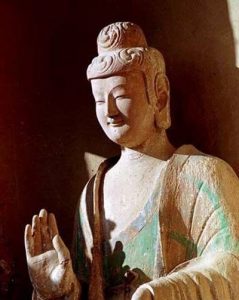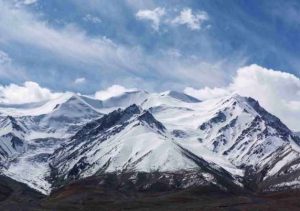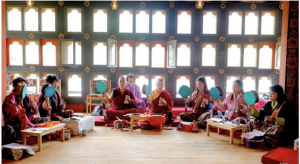
Commemorating the birth anniversary of the eighth-century Indian tantric master Padmasambhava, popularly known as Guru Rinpoche, over the weekend, the government of India presented a statue of the Buddha to Bhutan in the traditional seat of the country’s civil administration, Tashichho Dzong.
Two events to mark the auspicious occasion were organized by the Embassy of India to Bhutan and the Indian Council for Cultural Relations (ICCR), in collaboration with the Bhutanese government and Privy Council: the first, a formal handover ceremony for the statue of the Buddha was hosted on 19 June, the eve of Guru Rinpoche’s birth anniversary. A second ceremony was conducted on 20 June to consecrate and enshrine the statue at Tashichho Dzong.
Designed by the renowned Indian sculptor Naresh Kumar Kumawat, the cast bronze statue of the seated Buddha, depicting the meditative dhyana mudra, sits one meter tall and weighs about 200 kilograms.
Celebrating shared spiritual heritage at Tashichhodzong today with @EoI @iccr_hq Honored to have received this special gift, a statue of Lord Buddha, from the people and the GoI to the people of Bhutan on this auspicious day of the birth anniversary of Guru Rinpoche. pic.twitter.com/LSDGQBYMkH
— Foreign Minister of Bhutan (@FMBhutan) June 20, 2021
“This is a fitting tribute to our special relationship as the close bonds of friendship we enjoy today, have roots in our deep religious and spiritual connection,” said Bhutan’s foreign minister, Dr. Tandi Dorji, for the occasion at Tashichho Dzong. “Buddhism spread from its cradle in India and since its arrival in Bhutan, many great masters from India, most notable Guru Padmasambhava, traveled to our country and blessed the land and its people.” (Wion)
First constructed in 1216, Tashichho Dzong is a Buddhist monastery and fortress to the north of Bhutan’s capital city, Thimphu. The dzong has been seat of the Druk Desi, the head of Bhutan’s civil government, since 1952 and houses the throne room and offices of the king, the secretariat, and the ministries of home affairs and finance.
The presentation ceremony was conducted with prayers and blessings from His Eminence Tsugla Lopon Khenpo Karma Rangdrol and His Eminence Laytshog Lopen Sangay Dorji of the Zhung Dratshang—the Central Monastic Body of Bhutan. A ritual procession was held to receive the statue, with 300 monks of Tashichho Dzong chanting prayers.
“Every year thousands of Bhutanese travel to India on pilgrimage to sacred Buddhist sites in Bodh Gaya, Sarnath & Nalanda. This kind gesture from the People & Govt of India will reinforce connections between the Buddhist communities," said H.E. Tandi Dorji, Hon’ble @FMBhutan pic.twitter.com/pEbh1E6yry
— ICCR (@iccr_hq) June 20, 2021
The Indian ambassador to Bhutan, Ruchira Kamboj, presented the statue of the Buddha to the Dr. Tandi Dorji, in the presence of the chairman and councillor of the Privy Council, senior officials from the Foreign Affairs Ministry, and senior monastics. The lighting of butter lamps followed by a ceremonial masked cham dance completed the consecration of the statue for Guru Rinpoche’s birth anniversary.
Remote, landlocked, and perched in the rarified air of the eastern Himalaya, Bhutan is the world’s last remaining Vajrayana Buddhist kingdom. The ancient spiritual tradition is embedded in the very consciousness and culture of this remote land, where it has flourished with an unbroken history that dates back to its introduction from Tibet by Guru Padmasambhava in the eighth century.
Padmasambhava was a key figure in the transmission of the esoteric teachings of Vajrayana Buddhism from India across the Himalaya via Nepal, to Tibet, Bhutan, and beyond, and has over the centuries since been revered across the region as “the second buddha.” Bhutan has numerous pilgrimage sites associated with Guru Rinpoche, including the iconic Paro Taktsang or Tiger’s Nest monastery, where he is said to have meditated. The birth anniversary of Guru Rinpoche is a national holiday in Bhutan, traditionally observed on the 10th day of the sixth month of the lunar calendar—usually in June or July.

ICCR president Vinay Sahasrabuddhe said that the gift of the statue “symbolizes not just our age-old cultural ties, but also our shared commitment to the values that [the] Buddha taught us. . . . The relationship between Bharat [India] and Bhutan is laced with cultural bondage since time immemorial. . . . What was destroyed in Nalanda and other similar places are the assets saved by your monasteries, stupas . . . we owe a lot to our friends in Bhutan.” (Wion)
Founded in 1950 and headquartered in New Delhi, the ICCR is an autonomous organization under the central government with a focus on external relations through cultural exchange.
Roughly 75 per cent of Bhutan’s population of some 770,000 people identify as Buddhists, according to the Washington, DC-based Pew Research Center. The majority of the remaining 25 per cent, mainly people of the Lhotshampa ethnic group of Nepalese descent, practice Hinduism. Most of Bhutan’s Buddhists follow either the Drukpa Kagyu or the Nyingma schools of Vajrayana Buddhism.
See more
Gift of a statue of Lord Buddha from the Government and people of India to the Government and the people of Bhutan (Ministry of Foreign Affairs, Royal Government of Bhutan)
India gifts Lord Buddha statue to Bhutan on birth anniversary of Guru Rinpoche (East Mojo)
Cultural Connect: India gifts Bhutan statue of Buddha on Guru Rinpoche’s birth anniversary (Wion)
Related news reports from Buddhistdoor Global
India’s Largest Reclining Buddha Statue to be Installed in Bodh Gaya
UPDATE: South Korean Buddhist Temple Enshrines Buddha Statue Gift from India
Buddhist Bhutan Offers Prayers, Oxygen for India Battling COVID-19 Crisis
Buddhist Bhutan the First Nation to Receive Free COVID-19 Vaccines from India
In Historic Move, Himalayan Development Organization Appoints New Leader from Bhutan
Related features from Buddhistdoor Global
Precious Guru: Tracing the Wild and Sacred Legacy of Padmasambhava
Searching for the Lotus-Born Master: Following the Father of Vajrayana Buddhism’s Journey Across the Himalayas
Seeing the Sacred: an Interview with Pawo Choyning Dorji, Producer of Hema Hema: Sing Me A Song While I Wait












